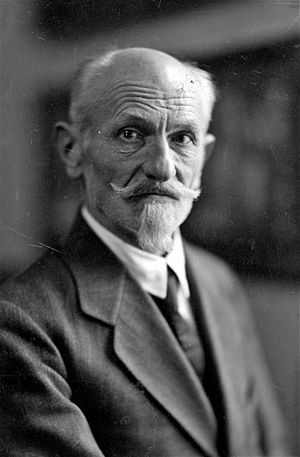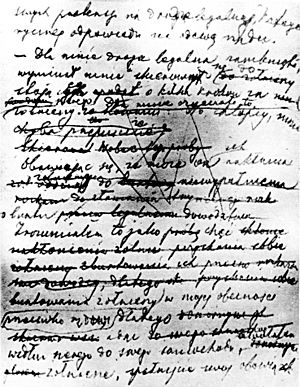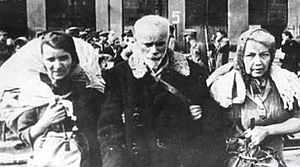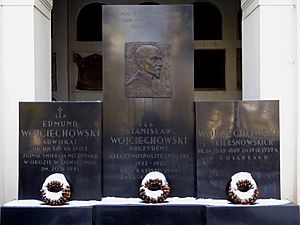Stanisław Wojciechowski facts for kids
Quick facts for kids
Stanisław Wojciechowski
|
|
|---|---|

Wojciechowski c. 1920s
|
|
| 2nd President of Poland | |
| In office 22 December 1922 – 14 May 1926 |
|
| Prime Minister | Władysław Sikorski Wincenty Witos Władysław Grabski Aleksander Skrzyński Wincenty Witos |
| Preceded by | Gabriel Narutowicz Maciej Rataj (Acting) |
| Succeeded by | Maciej Rataj (Acting) Ignacy Mościcki |
| Minister of Internal Affairs | |
| In office 16 January 1919 – 9 June 1920 |
|
| Prime Minister | Ignacy Jan Paderewski Leopold Skulski |
| Preceded by | Stanisław Thugutt |
| Succeeded by | Józef Kuczyński |
| Personal details | |
| Born | 15 March 1869 Kalisz, Kalisz Governorate, Congress Poland, Russian Empire |
| Died | 9 April 1953 (aged 84) Warsaw, Polish People's Republic |
| Resting place | Powązki Cemetery |
| Political party | Polish People's Party "Piast" |
| Spouse | Maria Kiersnowska (m. 1899) |
| Children | Edmund - Zofia |
| Relatives | Małgorzata Kidawa-Błońska (great-granddaughter) |
| Alma mater | University of Warsaw |
| Signature | |
Stanisław Wojciechowski (born March 15, 1869 – died April 9, 1953) was an important Polish politician and thinker. He served as the second President of Poland from 1922 to 1926. This was during a time known as the Second Polish Republic.
He became president in 1922 after the first president, Gabriel Narutowicz, was sadly killed. During his time as president, Wojciechowski and his old friend Józef Piłsudski had different ideas about how Poland should be run. In 1926, Piłsudski led a military action. This event caused Wojciechowski to resign from his position.
Contents
Early Life and Education
Stanisław Wojciechowski was born on March 15, 1869, in Kalisz. He came from a Polish noble family that valued education and learning. His father, Feliks Wojciechowski, was a prison caretaker who had taken part in the January Uprising. Stanisław was one of seven children. He was raised to love his country very much.
In 1888, he finished high school in Kalisz. He then started studying at the University of Warsaw, focusing on physics and mathematics. He was very active in secret student groups that aimed to improve themselves and their country. He joined a secret group called "Zet" and later became involved in the growing socialist movement. By 1892, he stopped his studies. After being arrested twice by the Russian police, he decided to leave Poland. He went to Zurich and then to Paris. There, he learned how to be a typesetter, which helped him earn a living.
Joining Political Movements
In 1892, Wojciechowski helped start the Polish Socialist Party in Paris. Many Polish nationalists and socialists met there. He traveled secretly back to Congress Poland and the Russian Empire several times. He smuggled printing machines and publications into the country. Along with Piłsudski, he became a key figure in the socialist movement in Russian Poland. In 1899, he married Maria Wojciechowska, whose family were wealthy landowners.
After 1905, he left the Polish Socialist Party. This was because he disagreed with their ideas about Poland's future and its place in the world. During World War I, Stanisław Wojciechowski believed that Germany was the biggest danger to Poland. So, he stayed in Russia instead of joining Piłsudski. After the Russians left Congress Poland in 1915, he moved to Moscow. He continued to be active in Polish political groups there.
After the Russian Tsar's government fell, he became president of the Council of Polish Parties' Union. He worked hard to help the Polish Army in Russia in 1918. He had to leave Moscow when the Bolsheviks took power, as he was at risk of arrest. On January 15, 1919, he was made Minister of Internal Affairs. He served in the governments of Ignacy Jan Paderewski and Leopold Skulski. During this time, Wojciechowski also helped write the Polish constitution.
Becoming President of Poland
First Presidential Election
In the 1922 elections, Wojciechowski tried to become a member of the Senate but did not win. After these elections, political power was split between different groups. The National Assembly had to choose a new president of Poland. Piłsudski did not want to run. Wincenty Witos was seen as someone who worked with right-wing groups and did not focus enough on rural areas.
So, the Polish People's Party "Piast" chose Wojciechowski as their candidate. He was seen as someone who was not involved in the usual political fights. He accepted this. However, Gabriel Narutowicz was also a candidate and was thinking of dropping out. Witos convinced Narutowicz to stay in the race.
Wojciechowski lost in the fourth round of voting to Maurycy Zamoyski. Narutowicz's strong performance was a surprise. In the end, Narutowicz won the election with support from left-wing parties, minority groups, and the "Piast" party. Narutowicz became the first president of the Second Polish Republic.
Second Presidential Election
Sadly, President Narutowicz was killed on December 16, 1922. Maciej Rataj, who was the head of the Sejm, became acting head of state for a short time. He quickly set a new election for December 20, 1922.
The right-wing parties put forward Kazimierz Morawski as their candidate. Wojciechowski was again suggested as a candidate everyone could agree on. Władysław Sikorski was also considered. At first, Wincenty Witos told his party, PSL, to vote for Morawski. However, the left-wing of PSL disagreed and decided to vote for Wojciechowski. They felt this was important after Narutowicz's death.
After much discussion, Wojciechowski's party decided to support him. In the first round, Wojciechowski won with 298 votes, while Morawski got 221. So, Wojciechowski won the election and became the second president of Poland. On December 20, 1922, Wojciechowski took his oath and officially became president.
His Time as President
During his presidency, Wojciechowski tried to be a very active leader. He was involved in how the government worked. He strongly supported the governments led by Władysław Sikorski and Władysław Grabski. He had the most political influence during Grabski's time as prime minister. Wojciechowski was part of the Political Committee of the Council of Ministers. He helped shape important laws, like the one about currency reform, which changed the Polish money.
Wojciechowski tried to improve Poland's government system. He wanted to make sure that if a government lost support, a new one could be formed smoothly. He also believed the Sejm (parliament) should meet continuously, not just in short sessions. He never officially closed the Sejm's sessions, even though the constitution said he could.
On September 5, 1924, Wojciechowski visited the city of Lwów (now Lviv, Ukraine). Someone threw an explosive device towards his car, but luckily, it did not explode. The person was arrested. Later, another person, Stanisław Steiger, was wrongly accused and imprisoned for a long time. Thanks to his lawyer, Natan Loewenstein, Steiger was found innocent and set free.
On May 7, 1925, Wojciechowski traveled from Warsaw to Kraków. At the train station, he asked soldiers if they sang religious songs. When they said yes, he asked them to sing some. They sang for about twenty minutes until his train left. This was a surprising moment for many people in the country.
The May Coup and Resignation
In November 1925, the government changed. Then, in May 1926, a new government was formed. Józef Piłsudski was very unhappy with the constant changes in government. He felt it was making Poland weak. He said he was ready to "fight the evil" of the parliament system and wanted to "restore health" to political life.
On May 12, 1926, Piłsudski's troops marched on Warsaw and took control of bridges. The government declared a state of emergency. Later that day, Piłsudski met President Wojciechowski on the Poniatowski Bridge. Piłsudski demanded that the current government resign. The President, however, demanded that Piłsudski surrender. Their talks failed.
To stop the fighting from turning into a civil war across the country, both Wojciechowski and Prime Minister Witos decided to resign on May 14. They ordered their troops to stop fighting. A new government was formed. Piłsudski was offered the presidency but declined. Eventually, Ignacy Mościcki became the new president. However, Piłsudski still held a lot of power behind the scenes.
Later Life and Legacy
His Work After Presidency
After resigning, Wojciechowski became a lecturer. He taught at the Warsaw School of Economics and the College of Agriculture in Warsaw. He also directed the Cooperative Scientific Institute and was part of its Scientific Council. He wrote books about cooperative activities, which he had been involved in before becoming a politician. His books included "Organization of Agricultural Products Sales" and "History of Polish Cooperatives until 1914." In 1937, he helped create the opposition Labor Party.
World War II and Family
On November 10, 1939, during World War II, Wojciechowski's son, Edmund, was arrested by the Gestapo. He was threatened with execution, like many other Polish intellectuals. Edmund was later released but arrested again in 1940. The Germans offered to release him if Wojciechowski signed a paper saying the Polish government-in-exile was illegal. Wojciechowski refused. Sadly, Edmund was sent to Auschwitz concentration camp and died there in 1941. The family received a telegram and an urn with his ashes.
During the Warsaw Uprising in 1944, Wojciechowski, who was ill, and his wife Maria were forced by the Nazis to leave Warsaw. They were sent to a transit camp in Pruszków.
His Final Years
Stanisław Wojciechowski lived a quiet life after the war. He died in 1953 at the age of 84. He was buried in Powązki Cemetery in Warsaw. Until the end of his life, he believed that the May Coup had been a turning point for the worse in Polish history.
Historians agree that Wojciechowski is an underrated figure. They believe he should be remembered as an important politician and statesman. He was a strong supporter of democratic values and a true patriot, especially during a very difficult time in Polish history.
See also
 In Spanish: Stanisław Wojciechowski para niños
In Spanish: Stanisław Wojciechowski para niños
- List of presidents of Poland
- Polish Socialist Party





